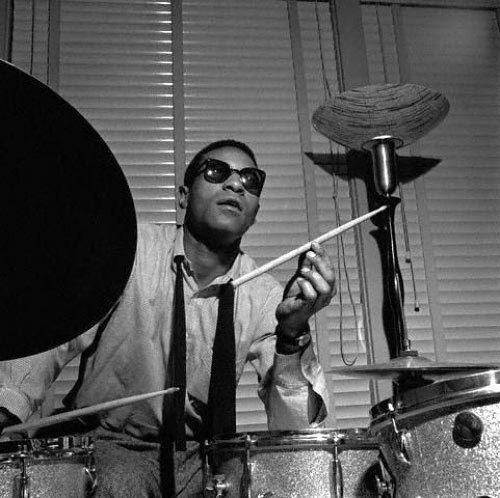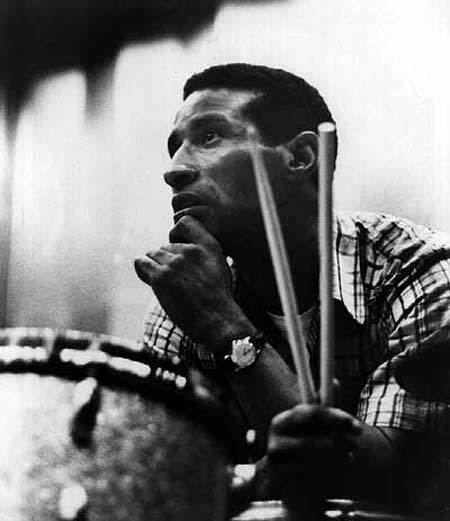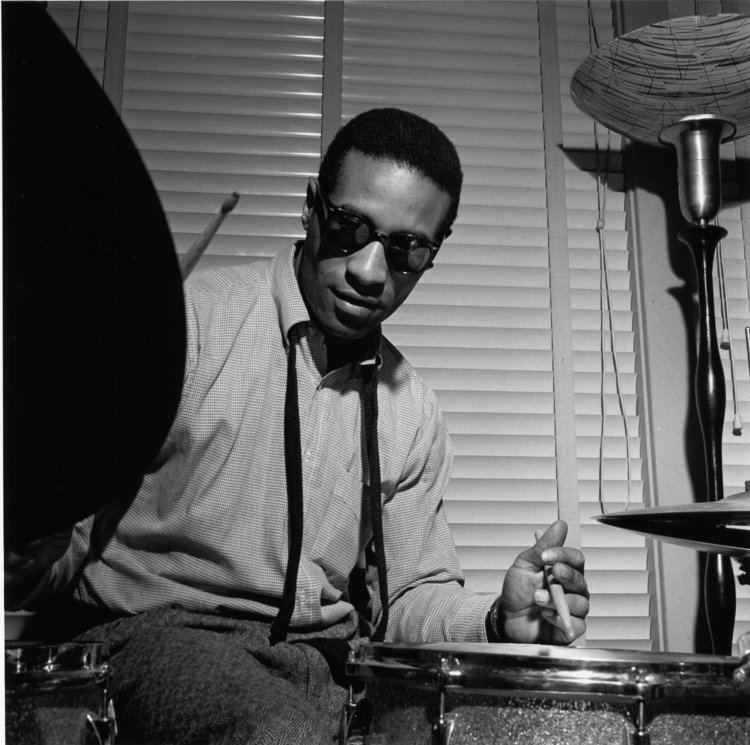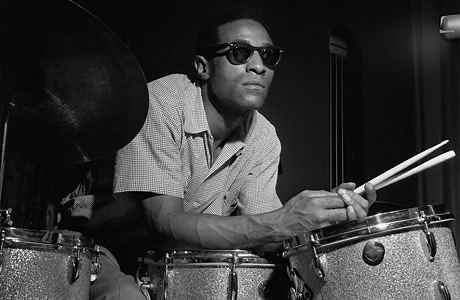Birth name Maxwell Lemuel Roach Name Max Roach | Instruments Drums, percussion Role Percussionist Years active 1944–2002 | |
 | ||
Albums Clifford Brown & Max Roach, We Insist!, Clifford Brown and Max Roa, Study in Brown, Percussion Bitter Sweet | ||
Max roach part 6 his autobiography accomplishments
Maxwell Lemuel Roach (January 10, 1924 – August 16, 2007) was an American jazz drummer and composer.
Contents
- Max roach part 6 his autobiography accomplishments
- Max roach the third eye
- Early life and career
- 1950s
- 1960s 1970s
- 1980s 1990s
- Death
- Personal life
- Style
- Honors
- Compilations
- As coleader
- References

A pioneer of bebop, Roach went on to work in many other styles of music, and is generally considered alongside the most important drummers in history. He worked with many famous jazz musicians, including Coleman Hawkins, Dizzy Gillespie, Charlie Parker, Miles Davis, Duke Ellington, Thelonious Monk, Charles Mingus, Billy Eckstine, Stan Getz, Sonny Rollins, Eric Dolphy, Booker Little, and Robert Stewart. He was inducted into the Down Beat Hall of Fame in 1980 and the Modern Drummer Hall of Fame in 1992.

Roach also led his own groups, notably a pioneering quintet co-led with trumpeter Clifford Brown and the percussion ensemble M'Boom, and made numerous musical statements relating to the Civil Rights Movement.

Max roach the third eye
Early life and career

Roach was born in the Township of Newland, Pasquotank County, North Carolina, which borders the southern edge of the Great Dismal Swamp, to Alphonse and Cressie Roach. Many confuse this with Newland Town in Avery County. Although Roach's birth certificate lists his date of birth as January 10, 1924, Roach has been quoted by Phil Schaap as having stated that his family believed he was born on January 8, 1925. Roach's family moved to the Bedford-Stuyvesant neighborhood of Brooklyn, New York when he was 4 years old. He grew up in a musical home, his mother being a gospel singer. He started to play bugle in parade orchestras at a young age. At the age of 10, he was already playing drums in some gospel bands. In 1942, as an 18-year-old fresh out of Boys High School, he was called to fill in for Sonny Greer with the Duke Ellington Orchestra when they were performing at the Paramount Theater.
In 1942, Roach started to go out in the jazz clubs of the 52nd Street and at 78th Street & Broadway for Georgie Jay's Taproom (playing with schoolmate Cecil Payne). His first professional recording took place in December 1943, supporting Coleman Hawkins.
He was one of the first drummers (along with Clarke) to play in the bebop style, and performed in bands led by Dizzy Gillespie, Charlie Parker, Thelonious Monk, Coleman Hawkins, Bud Powell, and Miles Davis. Roach played on many of Parker's most important records, including the Savoy November 1945 session, a turning point in recorded jazz. The drummer's early brush work with Powell's trio, especially at fast tempos, has been highly praised.
1950s
Roach studied classical percussion at the Manhattan School of Music from 1950 to 1953, working toward a Bachelor of Music degree (the School awarded him an Honorary Doctorate in 1990).
In 1952, Roach co-founded Debut Records with bassist Charles Mingus. This label released a record of a May 15, 1953 concert, billed as 'the greatest concert ever', which came to be known as Jazz at Massey Hall, featuring Parker, Gillespie, Powell, Mingus and Roach. Also released on this label was the groundbreaking bass-and-drum free improvisation, Percussion Discussion.
In 1954, Roach and trumpeter Clifford Brown formed a quintet that also featured tenor saxophonist Harold Land, pianist Richie Powell (brother of Bud Powell), and bassist George Morrow, though Land left the following year and Sonny Rollins soon replaced him. The group was a prime example of the hard bop style also played by Art Blakey and Horace Silver. This group was to be short-lived; Brown and Powell were killed in a car accident on the Pennsylvania Turnpike in June 1956. The first album Roach recorded after their deaths was Max Roach + 4. After Brown and Powell's deaths, Roach continued leading a similarly configured group, with Kenny Dorham (and later the short-lived Booker Little) on trumpet, George Coleman on tenor and pianist Ray Bryant. Roach expanded the standard form of hard-bop using 3/4 waltz rhythms and modality in 1957 with his album Jazz in 3/4 time. During this period, Roach recorded a series of other albums for the EmArcy label featuring the brothers Stanley and Tommy Turrentine.
In 1955, he was the drummer for vocalist Dinah Washington at several live appearances and recordings. Appearing at the Newport Jazz Festival with her in 1958 which was filmed and the 1954 live studio audience recording of Dinah Jams, considered to be one of the best and most overlooked vocal jazz albums of its genre.
1960s-1970s
In 1960 he composed and recorded the album We Insist!, subtitled Max Roach's Freedom Now Suite, with vocals by his then-wife Abbey Lincoln and lyrics by Oscar Brown Jr., after being invited to contribute to commemorations of the hundredth anniversary of Abraham Lincoln's Emancipation Proclamation. In 1962, he recorded the album Money Jungle, a collaboration with Mingus and Duke Ellington. This is generally regarded as one of the very finest trio albums ever made.
During the 1970s, Roach formed a musical organization—"M'Boom"—a percussion orchestra. Each member of this unit composed for it and performed on many percussion instruments. Personnel included Fred King, Joe Chambers, Warren Smith, Freddie Waits, Roy Brooks, Omar Clay, Ray Mantilla, Francisco Mora, and Eli Fountain.
1980s-1990s
In the early 1980s, Roach began presenting entire concerts solo, proving that this multi-percussion instrument could fulfill the demands of solo performance and be entirely satisfying to an audience. He created memorable compositions in these solo concerts; a solo record was released by Baystate, a Japanese label. One of these solo concerts is available on video, which also includes a filming of a recording date for "Chattahoochee Red", featuring his working quartet, Odean Pope, Cecil Bridgewater and Calvin Hill.
Roach embarked on a series of duet recordings. Departing from the style of presentation he was best known for, most of the music on these recordings is free improvisation, created with the avant-garde musicians Cecil Taylor, Anthony Braxton, Archie Shepp, and Abdullah Ibrahim. Roach created duets with other performers: a recorded duet with the oration by Martin Luther King, "I Have a Dream"; a duet with video artist Kit Fitzgerald, who improvised video imagery while Roach spontaneously created the music; a duet with his lifelong friend and associate Gillespie; a duet concert recording with Mal Waldron.
Roach wrote music for theater, such as plays written by Sam Shepard, presented at La Mama E.T.C. in New York City.
Roach found new contexts for presentation, creating unique musical ensembles. One of these groups was "The Double Quartet". It featured his regular performing quartet, with personnel as above, except Tyrone Brown replaced Hill; this quartet joined "The Uptown String Quartet", led by his daughter Maxine Roach, featuring Diane Monroe, Lesa Terry and Eileen Folson.
Another ensemble was the "So What Brass Quintet", a group comprising five brass instrumentalists and Roach, no chordal instrument, no bass player. Much of the performance consisted of drums and horn duets. The ensemble consisted of two trumpets, trombone, French horn and tuba. Musicians included Cecil Bridgewater, Frank Gordon, Eddie Henderson, Rod McGaha, Steve Turre, Delfeayo Marsalis, Robert Stewart, Tony Underwood, Marshall Sealy, Mark Taylor and Dennis Jeter.
Roach presented his music with orchestras and gospel choruses. He performed a concerto with the Boston Symphony Orchestra. He wrote for and performed with the Walter White gospel choir and the John Motley Singers. Roach performed with dancers: the Alvin Ailey American Dance Theater, the Dianne McIntyre Dance Company, the Bill T. Jones/Arnie Zane Dance Company.
Roach surprised his fans by performing in a hip hop concert, featuring the artist-rapper Fab Five Freddy and the New York Break Dancers. He expressed the insight that there was a strong kinship between the outpouring of expression of these young black artists and the art he had pursued all his life.
Not content to expand on the musical territory he had already become known for, Roach spent the decades of the 1980s and 1990s continually finding new forms of musical expression and presentation. Though he ventured into new territory during a lifetime of innovation, he kept his contact with his musical point of origin. He performed with the Beijing Trio, with pianist Jon Jang and erhu player Jeibing Chen. His last recording, Friendship, was with trumpeter Clark Terry, the two long-standing friends in duet and quartet. Roach's last performance was at the 50th anniversary celebration of the original Massey Hall concert, in Toronto, where he performed solo on the hi-hat.
In 1994, Roach also appeared on Rush drummer Neil Peart's Burning For Buddy performing "The Drum Also Waltzes", Part 1 and 2 on Volume 1 of the Volume 2 series during the 1994 All-Star recording sessions.
In 1991, Max Roach performed a duet with saxophonist Robert Stewart at UC Berkeley. Stewart performed with Max Roach's full ensemble a few months later at The World Stage in Los Angeles.
Death
Max Roach died in the early morning of August 16, 2007, in Manhattan. He was survived by five children: sons Daryl and Raoul, and daughters Maxine, Ayo and Dara. Over 1,900 people attended his funeral at Riverside Church in Manhattan, New York City, on August 24, 2007. Max Roach was interred at the Woodlawn Cemetery, The Bronx, New York City.
In a funeral tribute to Roach, then-Lieutenant Governor of New York David Paterson compared the musician's courage to that of Paul Robeson, Harriet Tubman and Malcolm X, saying that "No one ever wrote a bad thing about Max Roach's music or his aura until 1960, when he and Charlie Mingus protested the practices of the Newport Jazz Festival."
Personal life
Two children, son Daryl Keith Roach and daughter Maxine Roach, were born from Roach's first marriage with Mildred Roach in 1949. He continued to play as a freelance while studying composition at the Manhattan School of Music. He graduated in 1952. In 1958 he met singer Barbara Jai (Johnson) and fathered another son, Raoul Jordu. During the period 1961–1970, Roach was married to the singer Abbey Lincoln, who had performed on several of Roach's albums. In 1971, twin daughters, Ayodele Nieyela and Dara Rashida, were born to Roach and his third wife, Janus Adams Roach. He had four grandchildren: Kyle Maxwell Roach, Kadar Elijah Roach, Maxe Samiko Hinds, and Skye Sophia Sheffield. Long involved in jazz education, in 1972 he was recruited to the faculty of the University of Massachusetts Amherst by Chancellor Randolph Bromery. In the early 2000s, Roach became less active from the onset of hydrocephalus-related complications.
From the 1970s through the mid-1990s Roach taught at the University of Massachusetts Amherst.
Style
Roach started as a traditional grip player but switched exclusively to matched grip as his career progressed.
Roach's most significant innovations came in the 1940s, when he and jazz drummer Kenny Clarke devised a new concept of musical time. By playing the beat-by-beat pulse of standard 4/4 time on the "ride" cymbal instead of on the thudding bass drum, Roach and Clarke developed a flexible, flowing rhythmic pattern that allowed soloists to play freely. The new approach also left space for the drummer to insert dramatic accents on the snare drum, "crash" cymbal and other components of the trap set.
By matching his rhythmic attack with a tune's melody, Roach brought a newfound subtlety of expression to his instrument. He often shifted the dynamic emphasis from one part of his drum kit to another within a single phrase, creating a sense of tonal color and rhythmic surprise. The idea was to shatter musical conventions and take full advantage of the drummer's unique position. "In no other society", Roach once observed, "do they have one person play with all four limbs."
While that approach is common today, when Clarke and Roach introduced the new style in the 1940s it was a revolutionary musical advance. "When Max Roach's first records with Charlie Parker were released by Savoy in 1945", jazz historian Burt Korall wrote in the Oxford Companion to Jazz, "drummers experienced awe and puzzlement and even fear." One of those awed drummers, Stan Levey, summed up Roach's importance: "I came to realize that, because of him, drumming no longer was just time, it was music."
In 1966, with his album Drums Unlimited (which includes several tracks that are entirely drum solos) he demonstrated that drums can be a solo instrument able to play theme, variations, rhythmically cohesive phrases. He described his approach to music as "the creation of organized sound." The track "The drum also waltzes" was often quoted by John Bonham in his Moby Dick drum solo and revisited by other drummers like Neil Peart and Steve Smith. Bill Bruford performed a cover on the album Flags (1985).
Honors
Roach was given a MacArthur Foundation "genius" grant in 1988, cited as a Commander of the Ordre des Arts et des Lettres in France (1989), twice awarded the French Grand Prix du Disque, elected to the International Percussive Art Society's Hall of Fame and the Downbeat Magazine Hall of Fame, awarded Harvard Jazz Master, celebrated by Aaron Davis Hall, given eight honorary doctorate degrees, including degrees awarded by Medgar Evers College, CUNY, the University of Bologna and Columbia University. While spending the later years of his life at the Mill Basin Sunrise assisted living home, in Brooklyn, Max was honored with a proclamation honoring his musical achievements by Brooklyn borough president Marty Markowitz.
In 1986 the London borough of Lambeth named a park in Brixton after him. Roach was able to officially open it when he visited the UK that year invited by the Greater London Council, when he performed at a concert in March at the Royal Albert Hall together with Ghanaian master drummer Ghanaba and others.
Roach was inducted into the North Carolina Music Hall of Fame in 2009.
Compilations
As co–leader
With Clifford Brown
With M'Boom
